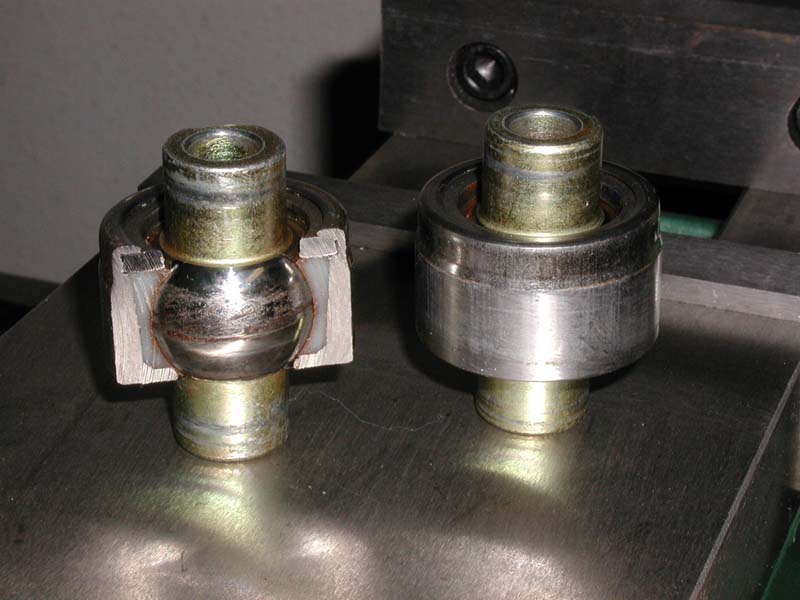Beefier trailing arm bushings... as OEM!
#26
Originally Posted by jimlab
Not according to the illustrations in the service highlights manual (just checked), and I'll be more than happy to machine one open for inspection this weekend if anyone cares strongly about it. 

#27
Originally Posted by potatochobit
is there any advantage to replace the whole trailing arm instead of just these bushings?
#28
Originally Posted by adam c
The arm is a piece of metal. There is no reason to replace it unless it has been damaged. Replaceing an undamaged arm would be a waste.
#29
Originally Posted by John Magnuson
Some people replace then because aftermarket ones are just a little bit thinner...
#30
Originally Posted by John Magnuson
You'll see some nice white nylon in there that the ball rotates on.
#31
Originally Posted by jimlab
In the two old ones that I inspected last night, there was no nylon liner that I saw. That may be a "new" addition, but since they come pre-packed with grease, I wasn't able to inspect the last new ones I bought closely before installing them.
But maybe I was smoking crack... who knows... hard habit to break.
About the aftermarket rear trailing arms giving more clearance due to being offset... you are correct Jim... which happens from time to time.

#32
Originally Posted by John Magnuson
The ones I saw the nylon liner on were the old original ones from my 93.
But maybe I was smoking crack... who knows... hard habit to break.
But maybe I was smoking crack... who knows... hard habit to break.

Since I have a couple old bushings and a mill, I'll crack one open this weekend just for laughs.
you are correct Jim... which happens from time to time. 


#34
Add another page to the popular book "You Learn Something Every Day"... 
The service highlight manual (thinner green manual) shows a cross section of all the bushings in the suspension and the areas which are rubber are designated with diagonal lines. An example is shown below, with the rubber in the cross section of the larger toe link bushing highlighted in light yellow.
Note the more closely spaced diagonal lines around the encase ball of the center shaft and on the outer seals. I assume that's also rubber, but didn't cut one apart to find out.

However, the illustration for the pillow bushings in the manual doesn't indicate that any other material is part of their composition; there are no diagonal lines. I've never seen the Nylon liner that John mentioned, but as you'll see, it's definitely there.
As it turns out, there's a large Nylon insert in the pillow bushings, and it's probably the wear of this portion of the bushing that allows the encased metal sleeve/ball to hit the front and the back of the metal outer casing, causing the clunking noise that many of you are probably familiar with. So without further ado, here's what the guts of your pillow bushings look like...

These are two of the pillow bushings that were in the control arms that Daniel (dclin) sent me. Notice the scoring on the bearing surface. I have no idea what would have caused that, because the rubber dust seals were intact as far as I could tell.

The service highlight manual (thinner green manual) shows a cross section of all the bushings in the suspension and the areas which are rubber are designated with diagonal lines. An example is shown below, with the rubber in the cross section of the larger toe link bushing highlighted in light yellow.
Note the more closely spaced diagonal lines around the encase ball of the center shaft and on the outer seals. I assume that's also rubber, but didn't cut one apart to find out.

However, the illustration for the pillow bushings in the manual doesn't indicate that any other material is part of their composition; there are no diagonal lines. I've never seen the Nylon liner that John mentioned, but as you'll see, it's definitely there.

As it turns out, there's a large Nylon insert in the pillow bushings, and it's probably the wear of this portion of the bushing that allows the encased metal sleeve/ball to hit the front and the back of the metal outer casing, causing the clunking noise that many of you are probably familiar with. So without further ado, here's what the guts of your pillow bushings look like...

These are two of the pillow bushings that were in the control arms that Daniel (dclin) sent me. Notice the scoring on the bearing surface. I have no idea what would have caused that, because the rubber dust seals were intact as far as I could tell.
Last edited by jimlab; 02-19-05 at 11:04 PM.
Thread
Thread Starter
Forum
Replies
Last Post
Devon300zx
2nd Generation Specific (1986-1992)
15
09-16-15 06:57 AM




